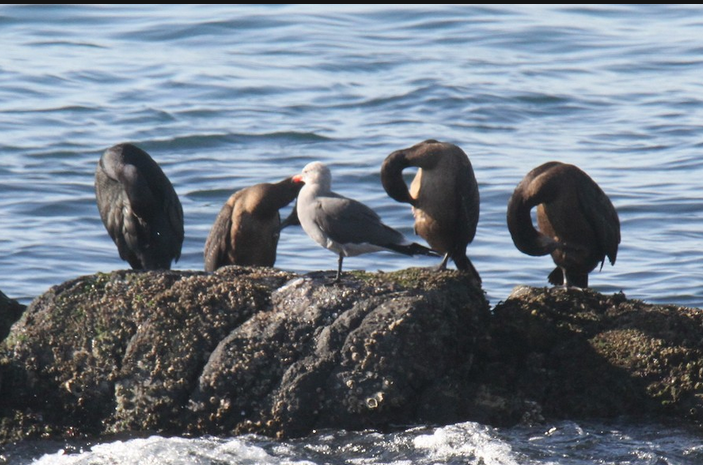 Daniel Donnecke has contributed his images and counts from a visit to race Rocks on October 30 to ebird.org
Daniel Donnecke has contributed his images and counts from a visit to race Rocks on October 30 to ebird.org
https://ebird.org/checklist/S61055064
 Daniel Donnecke has contributed his images and counts from a visit to race Rocks on October 30 to ebird.org
Daniel Donnecke has contributed his images and counts from a visit to race Rocks on October 30 to ebird.org
https://ebird.org/checklist/S61055064
The first gentle sou’east weather pattern with clouds and rain occurred in the last few days. The rain is most welcome to wash away a summers worth of gull and pinniped excrement. This island can be smelled from a kilometer away!
About 2/3s of the sea lions have left since the weather change. We are down to around 140 animals, perhaps 75 are Stellers down from the 175 of 10 days ago. Californians make up the remainder down from 225. Quite a few juveniles have showed up in the last week.
More birds are showing up. In the last few days several Harlequin ducks and a few dozen cormorants returned to dot the shoreline with the oystercatchers. Flocks of Bonaparte gulls feed on minnows in the eddies, forced to the surface from the deeper water by murres and rhinoceros auklets. Killdeers are spending the nights here. I hear them when I shut down the generator at night. Close to 30 sparrows are flitting about, and yesterday a few eagles and ravens were hunting and scavenging. Late developing gull chicks are on the menu. The flock of turnstones forages in the sea lion haulout ignored by the sea lions.
Tour boats are becoming less frequent and sport fishermen are waning too… yesterday for example a pod of orca passed with only 2 boats watching them rather than 8-10.
Bonaparte`s Gull is one of the smallest North American gull. The small size12″-14″( 33 cm) and light buoyant flight of They are reminiscent of terns. Wingspreads range from 24 to 63 in. (0.6-1.6 m).
Summer adults have black heads, grey mantles and white underparts and tail. The wings show white outer primaries with black trailing edges. The bill is slender and black. The legs and the feet are reddish-orange. In winter, the black head becomes white with dark round spot behind the eye. Juveniles show dark ear spot on the head. They have brown on the mantle, scapulars and sides of the breast. The tail is white with a black terminal band. The legs are pinkish. By late September, young birds have moulted into the first winter plumage, characterized by a narrow dark bar on the upper wings, a dark leading edge to the primaries, which together form an “M” across the upper surface of the wings. They lose the juvenile`s brown but retain the terminal band on the tail. In their first summer, they begin to show a dark hood, and the”M” pattern on the wings begins to fade through wear. Bonaparte`s Gull attain adult winter plumage in their second year.
They are escpecially common in late August , September and October when swarms of Krill enter the waters.
Bonaparte`s Gulls are present in Race Rocks as omnivores. They feed on insects, worms, fish, mollusks, crustaceans in Pedder Bay and in the waters from Pedder Bay out to Race Rocks. They nest as isolated pairs or in small colonies, in other parts of British Columbia
Domain Eukarya
Kingdom Animalia
Phylum Chordata
Subphylum Vertebrata
Class Aves
Order Charadiformes
Genus Larus
Species philadelphia
Common Name: Bonaparte`s gull
Websites and references:
http://www.birds.cornell.edu/BOW/BO NGUL/
Peterson Field Guides. Peterson , Roger Tory. “Western Birds”. third edition(1990) Hougthon Mifflin Press: p. 96,102
|
Other Members of the Class Aves at Race Rocks.
|
and Image File |
 The Race Rocks taxonomy is a collaborative venture originally started with the Biology and Environmental Systems students of Lester Pearson College UWC. It now also has contributions added by Faculty, Staff, Volunteers and Observers on the remote control webcams. December 2002- Giulio Esposito PC year 29 The Race Rocks taxonomy is a collaborative venture originally started with the Biology and Environmental Systems students of Lester Pearson College UWC. It now also has contributions added by Faculty, Staff, Volunteers and Observers on the remote control webcams. December 2002- Giulio Esposito PC year 29 |
‘This morning after the students returned to Pearson College, Garry and Mark took out fourteen international visitors from a conference on Sea Ducks in Victoria. They were particularly impressed by the assortment of bird life on the way out, Belted Kingfishers, Great Blue Herons, Double- Crested Cormorants, and Bonaparte”s Gulls were common, Rhinocerous Auklets and a flock of , 6 Ancient Murrelets as well as several flocks of Marbled Murrelets -20+) were an added bonus. A few Western Grebes were also in the Pedder Bay region. Double Crested Cormorants, Western and Thayer”s gulls were the most common around Race Rocks, with a few juvenile Glaucous winged gulls mixed in. ‘, ‘Garry Fletcher’, ’22:05:42 ,